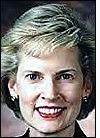In her keynote address yesterday, Carolyn Walton, Wal-Mart‘s vice president of information systems, kicked off the final day of the fourth annual RFID Journal LIVE! conference with a message echoed by many end users at the show: To make RFID work, you must take risks. “Stick your neck out,” she urged.
At the same time, Walton also encouraged attendees to start small, complying with any retailer tagging requests they might face, but also learning about RFID and what it can do for their companies. “You can’t leap-frog into [RFID] and launch a full deployment,” she said.
Of the RFID end users in attendance, the largest share was made up of representatives from consumer packaged goods companies. And while most of this group is looking to deploy RFID to comply with requests from Wal-Mart, Target, Albertsons, Best Buy and other retailers, a good number are keen to discover ways their internal operations can benefit from the technology.
“We’re here to solidify which vendors we will be working with,” said Dennis Upton, chief information officer for Brother International Corp., a manufacturer of copiers, sewing machines and other consumer goods. The company faces a mandate to begin tagging some shipments headed for Wal-Mart next year. “It’s going to cost us to use RFID, so if we can get some benefit out of it—other than keeping Wal-Mart as a customer—we’ll do it.”
Walton provided updates on Wal-Mart’s RFID program execution, saying five distribution centers, 475 Wal-Mart stores and 36 Sam’s Club locations are now RFID-enabled and receiving a combined total of 3,000,000 tagged cases each week.
Walton also discussed the internal benefits some of its suppliers have leveraged using feedback from Wal-Mart regarding the locations and times at which the retailer reads case tags. Through this feedback, she said, Hanna’s Candle Co. discovered that a full truckload of its candle products had been received into the yard of a Wal-Mart DC, but was left there, unloaded. This discovery helped Hanna’s and Wal-Mart avoid missing sales on the seasonal products still sitting in the truck.
Wal-Mart’s goals for the upcoming year include providing its sales associates with handheld interrogators (readers) that will seek specific EPCs in backroom inventory, alerting them to the tag’s presence as the associate waves the reader past shelves of cased product. Walton also noted the significant reductions in out-of-stock instances attributed to the use of RFID, discovered through a research project launched by the University of Arkansas (see RFID’s Impact at Wal-Mart Greater Than Expected).
Still, while many sessions and exhibit floor conversations among the 2,500 attendees revolved around the use of passive RFID technology in the supply chain, this year’s conference had a broad focus on other applications of RFID, as well. “The great ideas won’t necessarily be in your own verticals,” Walton told attendees, encouraging them to visit the breakout sessions focused on vertical markets outside of retail, such as health care, pharmaceuticals, aerospace, manufacturing and logistics.
At an academic convocation held during the conference, attendees discussed ways RFID can be integrated into the pharmaceutical supply chain, and how the academic community is studying whether RFID radiation threatens to alter the molecular make-up of drugs in tagged containers. The use of RFID in building an electronic pedigree, to authenticate a chain of custody for drugs from the point of manufacture to the point of sale, is an important topic in light of state and possible federal legislation that could require such an application.
End users at the conference wanted to discuss the implications attaching RFID tags to products or objects carried by consumers and employees might have on personal privacy rights. “I’m here for the privacy and data-protection sessions, and to learn about the technology,” said Fred Child, research and development manager for Nationwide Building Society, a U.K.-based financial services company piloting RFID for building access control. “And yesterday, I thought of a new project that I can deploy, based on what I saw here.”
Additionally, durable reusable tags continue to garner interest, both from companies using RFID to comply with mandates and those considering it for internal uses, tracking reusable assets. Dow Chemical is studying how it might use RFID asset tags attached to its shipping containers to improve the visibility and upkeep of the containers (see Dow Reveals a Chemical Attraction to RFID). Symbol and Intermec, meanwhile, released ruggedized, reusable passive Gen 2 asset tags during the show, indicating a move away from the active (battery-powered) tags generally used for asset tracking.
“It’s scary how fast RFID technology is changing,” said Robert Miller, an attendee representing PolyTubes, a supplier of pipes for the industrial and retail markets. Miller is looking into ways his company might use asset tags to ensure order accuracy when shipping large rolls of piping. “I’m talking to a lot of vendors, but I’m trying to take the hype out of the conversation. Vendors are overselling their products, and they would do themselves a favor if they would concentrate on the true pluses and minuses of their products.”
Miller’s not alone in his frustration as he searches for a workable solution to his business problem. Carol Coren, community programs director at Oregon State University’s College of Agricultural Sciences gave a blunt view of the state of RFID technology in a session on RFID research requirements for health and sciences applications: “RFID is not nanotechnology,” she said. “It’s 50 years old, and we need to make it grow up and do what we need it to do.”


